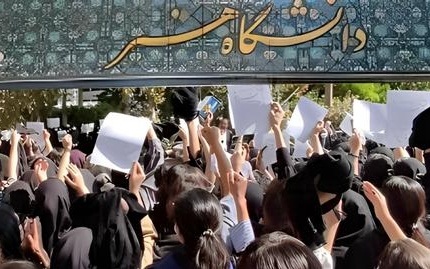A “Woman, Life, Freedom” protest at an Iranian university
Originally published by The Guardian:
Young Iranians have taken their protests against the authoritarian regime underground one year on from the death in custody of a 22-year-old woman detained for allegedly wearing the Islamic headscarf incorrectly.
The death of Mahsa Amini on 16 September last year led to the largest wave of popular unrest for years in Iran and a brutal crackdown by security services in response, with hundreds of men, women and children killed and thousands more injured, according to human rights groups.
Young Iranians who spoke to the Guardian say they have continued to protest secretly. “We may have quit the street protests temporarily but we haven’t quit the protests,” says “Reza”, a Tehran-based DJ and university student, who says he plays “revolution-driven” music to keep “the momentum” going.
I protested the first two months and somehow managed not to get hit by a pellet. Soon after we found out about the first execution, we were warned by our parents and professors to quit protesting on the streets. That’s when we came up with the idea of night protests.
Reza and his university colleagues, both male and female, have organised underground action in the capital.
One of our preferred ways of protesting is to go near government offices and cover the walls in freedom posters. We come back and play music, especially [songs] that are frowned on by the fascist regime.
We had a Shervin Hajipour [the Iranian singer arrested after his protest song “Badaye” went viral] protest the evening after he won the Grammy award to celebrate our fight for freedom. Everything we do in these night protests is considered normal for teens in the west – like women dancing, singing, not wearing a scarf – yet we have to do them in secret.
These get-togethers keep us united and motivate us to keep fighting in every way possible.
“Golnaz”, a 19-year-old economics student from Isfahan, regularly attends underground protests and has channelled her love for art into a form of dissent.
Many think the get-togethers happen only inside homes and in attics or garages. We do go outside and protest in many ways.
At the risk of getting caught, I have been riding bikes without a hijab and have successfully covered walls with graffiti. We then come back to one of our friends’ homes, and we stay awake, dance, sing and try to bring back our university colleagues to the streets in protest.
We women have never stopped protesting. We continued to defy the mandatory hijab, and we don’t see that changing in the near future.
Students in Mashhad, one of the most religious cities in Iran and the home town of the country’s supreme leader, Ayatollah Ali Khamenei, say they have also gone out on the streets to test the level of violence used by security forces.


Khamenei ‘grants permission’ for direct Iran-US nuclear talks: https://amwaj.media/article/scoop-khamenei-grants-permission-for-direct-iran-us-nuclear-talks
“Speaking on condition of anonymity, senior Iranian sources said top nuclear negotiator Ali Baqeri-Kani is ready to meet with White House Coordinator for the Middle East and North Africa Brett McGurk in Oman as early as the coming weeks. If the sought session materializes, the sources charged, the next step would be for the five permanent members of the UN Security Council (Britain, France, China, Russia, and the US) and Germany to convene a meeting with Iran. One source speculated that if the latter gathering takes place, it could follow ‘Transition Day’ under the Joint Comprehensive Plan of Action (JCPOA), namely Oct. 18. However, some experts have painted a far less ambitious picture, highlighting the need for a sober understanding of the substantial time commitment and complexities involved in reaching a deal.”
What countries have normalised relations with Iran after Saudi detente? https://www.aljazeera.com/news/2023/9/24/what-countries-have-normalised-relations-with-iran-after-saudi-detente
“The rapprochement between Iran and Saudi Arabia has led to profound changes beyond the borders of both regional powers. Tehran has normalised relations with several other countries, and efforts are under way to make changes to help stabilise the region and reduce tensions.”
[Editor’s Note: An “underground protest” is an expression of the call for rights, justice, and gender equality through a means other than a mass daytime gathering in public.
Anyone reading the article will find several examples of this, taken from first-hand testimony by participants.]
What, on earth, is an “underground protest” and how do you verify their taking place?
As that famous saying goes, ignorance is a bliss….